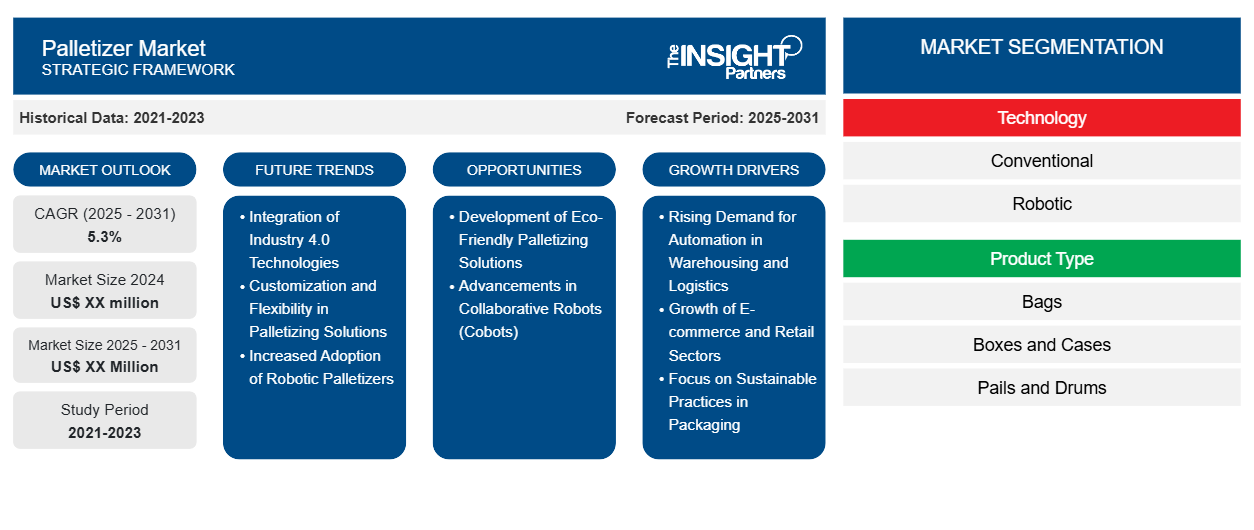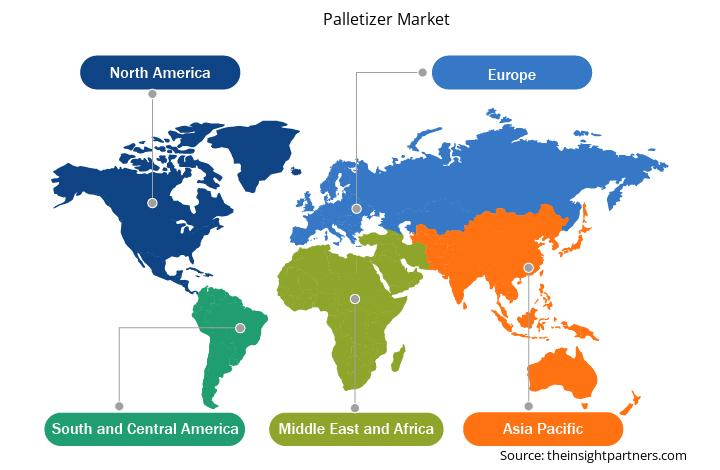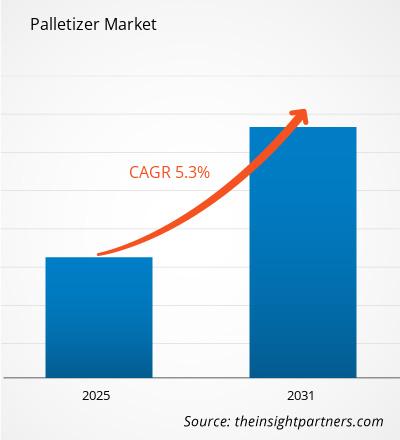预计码垛机市场在 2025 年至 2031 年期间的复合年增长率为 5.3%,市场规模将从 2024 年的 XX 百万美元扩大到 2031 年的 XX 百万美元。
本报告按技术(传统技术、机器人技术)、产品类型(袋装、盒装、桶装和桶装)、行业(食品饮料、化学品、制药、化妆品及个人护理、电子商务和零售)进行细分。全球分析进一步细分为区域和主要国家。报告提供上述分析和细分领域的美元价值。
报告目的
Insight Partners 发布的《码垛机市场》报告旨在描述码垛机市场的现状和未来增长、主要驱动因素、挑战和机遇。该报告将为各业务利益相关者提供洞见,例如:
- 技术提供商/制造商:了解不断变化的市场动态并了解潜在的增长机会,使他们能够做出明智的战略决策。
- 投资者:对市场增长率、市场财务预测以及整个价值链中存在的机会进行全面的趋势分析。
- 监管机构:规范市场政策和警察活动,旨在最大限度地减少滥用行为,维护投资者的信任和信心,维护市场的完整性和稳定性。
码垛机市场细分
技术
- 传统的
- 机器人
产品类型
- 包
- 盒子和箱子
- 桶和鼓
行业
- 食品和饮料
- 化学品
- 制药
- 化妆品和个人护理
- 电子商务和零售
地理
- 北美
- 欧洲
- 亚太地区
- 中东和非洲
- 南美洲和中美洲
定制此报告以满足您的要求
您可以免费定制任何报告,包括本报告的部分内容、国家级分析、Excel 数据包,以及为初创企业和大学提供优惠和折扣
码垛机市场:战略洞察

- 获取此报告的顶级关键市场趋势。此免费样品将包括数据分析,从市场趋势到估计和预测。
码垛机市场的增长动力
- 仓储和物流自动化需求不断增长:随着各行各业寻求提高运营效率并降低人工成本,对自动化码垛系统的需求也日益增长。自动化码垛机简化了包装和运输流程,最大限度地减少了人为错误并提高了吞吐量。这种向自动化的转变源于对更快订单履行速度和处理大量产品能力的需求,尤其是在电子商务、食品饮料和消费品等行业。因此,企业正在大力投资先进的码垛解决方案,以保持竞争力。
- 电子商务和零售业的增长:电子商务的爆炸式增长导致对高效包装和运输解决方案的需求激增。随着在线零售的不断扩张,企业面临着管理日益增多的产品种类和订单规模的挑战。自动化码垛机能够优化码垛流程,缩短装运准备时间,并确保产品安全包装以便运输,从而帮助企业应对这些挑战。这一趋势是码垛机市场增长的关键驱动力。
- 注重包装的可持续实践:环境问题正促使各行各业采用更具可持续性的实践,包括在包装流程中。自动码垛机可以通过优化材料使用和减少浪费来促进可持续发展目标。通过提高托盘堆垛效率并最大限度地减少包装材料的使用,企业可以降低其环境足迹。对可持续性的关注,加上减少浪费的监管压力,正在推动各行各业采用先进的码垛技术。
码垛机市场未来趋势
- 工业 4.0 技术集成:码垛机市场正日益受到工业 4.0 技术(包括物联网 (IoT)、人工智能 (AI) 和机器学习)的影响。这些技术有助于实时监控和数据分析,从而实现预测性维护并提高运营效率。智能码垛系统能够适应不同的产品尺寸和重量,从而提高生产线的灵活性。这一趋势正在将传统的码垛流程转变为更智能、适应性更强的系统。
- 码垛解决方案的定制化和灵活性:为了适应多样化的产品类型和包装样式,码垛解决方案的定制化趋势日益增长。制造商越来越多地提供模块化、灵活的码垛系统,这些系统可以轻松适应不断变化的生产需求。这种定制化使企业能够优化运营、减少停机时间并快速响应市场需求。随着消费者偏好的演变,这种定制化解决方案的趋势正成为码垛机制造商关注的重点。
- 机器人码垛机的普及率不断提升:机器人码垛机因其多功能性、速度和效率而日益受到青睐。与传统码垛机不同,机器人系统可以处理各种产品和包装配置。在产品频繁更换或负载大小变化的环境中,它们尤其具有优势。能够对机器人进行编程以执行不同任务,提高了灵活性,并减少了人工干预的需求。这一趋势正在重塑码垛机市场,越来越多的公司投资机器人解决方案来优化运营。
码垛机市场机遇
- 开发环保码垛解决方案:随着对可持续性的日益重视,制造商有机会开发环保码垛解决方案。这包括使用可生物降解材料、节能系统以及减少包装过程中浪费的技术。通过专注于可持续实践,制造商可以在竞争激烈的市场中脱颖而出,吸引具有环保意识的消费者,从而提高市场份额和品牌忠诚度。
- 协作机器人 (Cobot) 的进步:协作机器人 (Cobot) 的兴起正在彻底改变码垛市场。Cobot 旨在与人类操作员协同工作,提高工作场所的生产力和安全性。随着各行各业寻求将人类智能与机器人效率相结合,将 Cobot 集成到码垛流程中将带来巨大的增长机会。Cobot 能够适应各种任务和环境,对于那些希望在不大规模重新配置现有系统的情况下增强码垛操作的公司来说,Cobot 是一个极具吸引力的解决方案。
码垛机市场区域洞察
Insight Partners 的分析师已详尽阐述了预测期内影响码垛机市场的区域趋势和因素。本节还讨论了北美、欧洲、亚太地区、中东和非洲以及南美和中美的码垛机市场细分和地域分布。

- 获取码垛机市场的区域特定数据
码垛机市场报告范围
| 报告属性 | 细节 |
|---|---|
| 2024年的市场规模 | XX百万美元 |
| 2031年的市场规模 | XX百万美元 |
| 全球复合年增长率(2025-2031) | 5.3% |
| 史料 | 2021-2023 |
| 预测期 | 2025-2031 |
| 涵盖的领域 | 按技术
|
| 覆盖地区和国家 | 北美
|
| 市场领导者和主要公司简介 |
|
码垛机市场参与者密度:了解其对业务动态的影响
码垛机市场正在快速增长,这得益于终端用户需求的不断增长,而这些需求又源于消费者偏好的不断变化、技术进步以及对产品优势的认知度不断提升等因素。随着需求的增长,企业正在扩展产品线,不断创新以满足消费者需求,并抓住新兴趋势,从而进一步推动市场增长。
市场参与者密度是指特定市场或行业内企业或公司的分布情况。它表明特定市场空间内竞争对手(市场参与者)的数量相对于其规模或总市值而言。
在码垛机市场运营的主要公司有:
- 凯傲集团
- 发那科公司
- 库卡股份公司
- 霍尼韦尔国际公司
- 克朗斯股份公司
免责声明:以上列出的公司没有按照任何特定顺序排列。

- 获取码垛机市场顶级关键参与者概览
主要卖点
- 全面覆盖:该报告全面涵盖了码垛机市场的产品、服务、类型和最终用户的分析,提供了整体概况。
- 专家分析:本报告基于对行业专家和分析师的深入了解而编写。
- 最新信息:该报告涵盖了最新信息和数据趋势,确保了业务相关性。
- 定制选项:此报告可以定制以满足特定客户要求并适合业务策略。
因此,这份关于码垛机市场的研究报告有助于解读和理解行业现状及增长前景。尽管存在一些合理的担忧,但本报告的总体优势往往大于劣势。
- 历史分析(2 年)、基准年、预测(7 年)及复合年增长率
- PEST和SWOT分析
- 市场规模、价值/数量 - 全球、区域、国家
- 行业和竞争格局
- Excel 数据集
近期报告
客户评价
购买理由
- 明智的决策
- 了解市场动态
- 竞争分析
- 客户洞察
- 市场预测
- 风险规避
- 战略规划
- 投资论证
- 识别新兴市场
- 优化营销策略
- 提升运营效率
- 顺应监管趋势




















 获取免费样品 - 码垛机市场
获取免费样品 - 码垛机市场